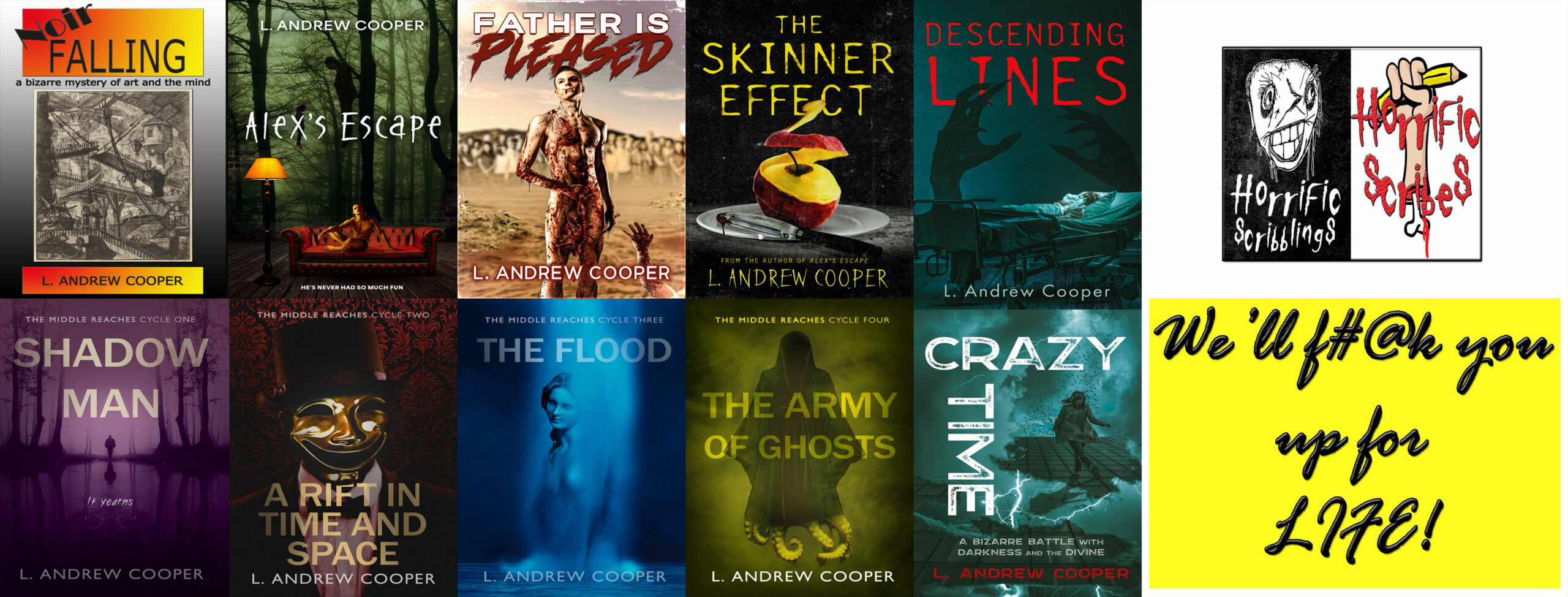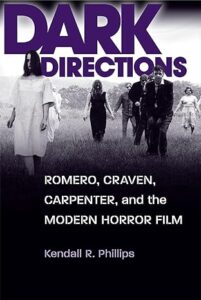Guest Post: Celebrating Horror’s Golden Ages by Kendall R. Phillips (2023)
The prominence of horror films at the box office and of horror novels on bookshelves suggests that ours is an age obsessed with the monstrous and macabre. Films such as The Invisible Man (2020), Nope (2022), and Talk to Me (2023) have been both critically hailed and commercially successful. Innovative horror novelists such as Stephen Graham Jones, Victor LaValle, Silvia Moreno-Garcia, N.K. Jemisin, and Paul Tremblay have led many bookstores to expand their horror sections, shelves that previously only housed tomes from members of the Stephen King household. The prevalence of horror on page and silver screen has been matched by its popularity on the small screen in television shows such as American Horror Story, The Haunting of Hill House, and 30 Coins and in countless horror-related video games. Indeed, horror narratives are so ubiquitous at the moment I would suggest that we are living in a golden age of horror.
Ours is not, to be clear, the only golden age of horror. In my estimation, we are in the third golden age. The first was that period of the 1930s when the horror genre first emerged as a recognizable category of popular culture. Indeed, it was in 1931, in-between the surprising success of Tod Browning’s Dracula and James Whale’s Frankenstein, that popular publications and movie theaters began using the term “horror film,” and the name stuck. Of course, there were horrific images and stories in motion pictures during the silent era. But those images and stories never quite coalesced into a recognizable genre, and, indeed, American filmmakers generally preferred their ghosts and monsters to be hoaxes or tricks in stories that largely prefigured Scooby Doo. In many of these films, as I discuss in A Place of Darkness: The Rhetoric of Horror in Early American Cinema, the frightening supernatural entity ends up being some uncle trying to steal an inheritance or unscrupulous real estate agent trying to get the “haunted house” at a bargain price.
While clearly borrowing from silent era films like The Cabinet of Dr. Caligari (1920) and The Cat and the Canary (1927), Dracula and Frankenstein were different. The monsters in Universal’s horror films were real, and the supernatural was not a hoax or misperception, it was a terrifying threat. In the darkest days of the Great Depression, Americans flocked to theaters to see these and other horrific monsters. The success of Dracula and Frankenstein opened the door for a cavalcade of monsters ranging from The Mummy (1932) to Cat People (1942).
Interestingly, the commercial success of the newly christened “horror films” at the box office led to the emergence of horror programming on the radio. Anthology shows like Light’s Out and The Witch’s Tale premiered in the early 1930s and brought the macabre and horrifying into the homes of everyday citizens through the airwaves. These shows were both so frightening and so popular that there were public calls for their elimination and even proposals for formal governmental censorship to restrict horror on the airwaves. But America’s appetite for the horrific continued.
The first golden age of horror laid the foundation for horror narratives, and throughout the 40s and 50s, horror would continue evolving, shifting from monsters lurking in crumbling castles to creatures arriving from outer space. In 1968, however, that foundation dramatically shifted, and the second golden age of horror began. 1968 could be considered, along with 1931, as one of the best years in the history of horror. Roman Polanski’s Rosemary’s Baby was a box office and Oscar success, but the real herald of a new golden age was released to much less fanfare. Independently produced by a group of Pittsburgh industrial filmmakers, Night of the Living Dead opened the floodgates for a new more brutal, nihilistic, and graphic tone in horror. George Romero’s masterpiece was soon followed by films such as Wes Craven’s Last House on the Left (1972), Tobe Hooper’s Texas Chainsaw Massacre (1974), and John Carpenter’s Halloween (1978). In my book Dark Directions: Romero, Craven, Carpenter and the Modern Horror Film, I argue that these independent filmmakers rewrote the formula for horror and became the architects of a new era of frightening films.
Even as critics typically reviled these low-budget shockers, audiences flocked to midnight screenings to see them, and the studios soon followed along with bigger budget horror films like The Exorcist (1973), The Omen (1976), and Alien (1979).
Perhaps not surprisingly, the prevalence of horror on the silver screen permeated other aspects of American popular culture. Bands like Alice Cooper and Black Sabbath embraced dark tones and macabre tales. Television would also see a dramatic shift in the tone and style of horror narratives. While anthology series such as The Twilight Zone and The Night Gallery had been popular, a crucial shift in horror television occurred in 1972 with the release of a television movie entitled The Night Stalker. This horror movie became the highest rated TV movie in history and led to a second television movie, The Night Strangler (1973), and the short-lived but influential series Kolchak: The Night Stalker (1974-1975). At the heart of The Night Stalker is Carl Kolchak, a tough-talking newspaper reporter who consistently discovers supernatural entities, a vampire in Las Vegas, a werewolf on a cruise ship, a Hindu demon in city alleys. While hampered by a low budget and narrative inconsistencies, the Kolchak episodes proved to television creators that a horror narrative could focus not on the monster or on the victim but on the monster hunter.
Indeed, as I argue in a recently published entry into the “TV Milestones Series,” Kolchak: The Night Stalker is the foundation upon which shows like Buffy the Vampire Slayer, The X-Files, Supernatural, and Lovecraft Country were developed.
The horror tales of the last decades of the twentieth century continued developing, challenging, and shifting the core structures of the second golden age, but a recent seismic shift may have ushered in a new golden age. If I were to nominate a film as the beginning of this new era, I would pick Jordan Peele’s Get Out (2017). Critically acclaimed and much discussed, Peele’s film may not be the first political horror film, but it is certainly a film that lays out its political critique with explicit and damning clarity. Get Out depicts the systems of white privilege and anti-Black violence in ways that shifted public discussions and set the stage for a renewed interest in and respect for horror. While I am loathe to embrace terms like “elevated” or “smart” horror, I cannot ignore the way contemporary audiences are now turning to horror stories for insights into their culture. Hence, a third golden age of horror has dawned.
Now, to be clear, I don’t talk about golden ages of horror in order to dismiss other periods of the genre. There are, without a doubt, provocative horror films that were produced outside these particular periods – films such as Invasion of the Body Snatchers (1956) and Psycho (1960). But these golden ages tend to be distinct in at least three ways. First, they are periods of remarkably productive horror filmmaking, and, as I’ve suggested above, these films often spark interest in horror across other mediums like print, radio, and television. Second, they are periods in which horror narratives are both popular and provocative. During golden ages, audiences don’t just go to watch horror films, but discuss and debate them. Third, and perhaps most interestingly, each of these golden ages occurs during a period of notable social upheaval: the Great Depression, the violence of the late 1960s, the political turmoil of the late 2010s. Almost twenty years ago, I argued, in a book entitled Projected Fears: Horror Films and American Culture, that horror narratives work best when they “resonate” with the wider anxieties and fears in the culture.
The intervening twenty years have reinforced my sense that horror films perform important rhetorical work for the culture, creating a safer space for engaging that which we fear. The darker the world around us, it would seem, the more likely we are to ponder it through the dark mirror of the horror genre.
About the Author
Kendall R. Phillips is professor of communication and rhetorical studies at Syracuse University, where he researches and teaches about the intersection of politics and popular culture. His work engages topics like public memory, popular film, and popular culture. He has published several books, including: A Cinema of Hopelessness: The Rhetoric of Refusal in 21st Century American Film; A Place of Darkness: The Rhetoric of Horror in Early American Cinema; and Projected Fears: Horror Films and American Culture. His essays have appeared in such journals as Quarterly Journal of Speech, Communication Monographs, and Philosophy and Rhetoric, and he is co-editor for the book series “Horror and Monstrosity Studies” at the University Press of Mississippi and “Rhetoric, Politics, and Society” for Palgrave Macmillan.





